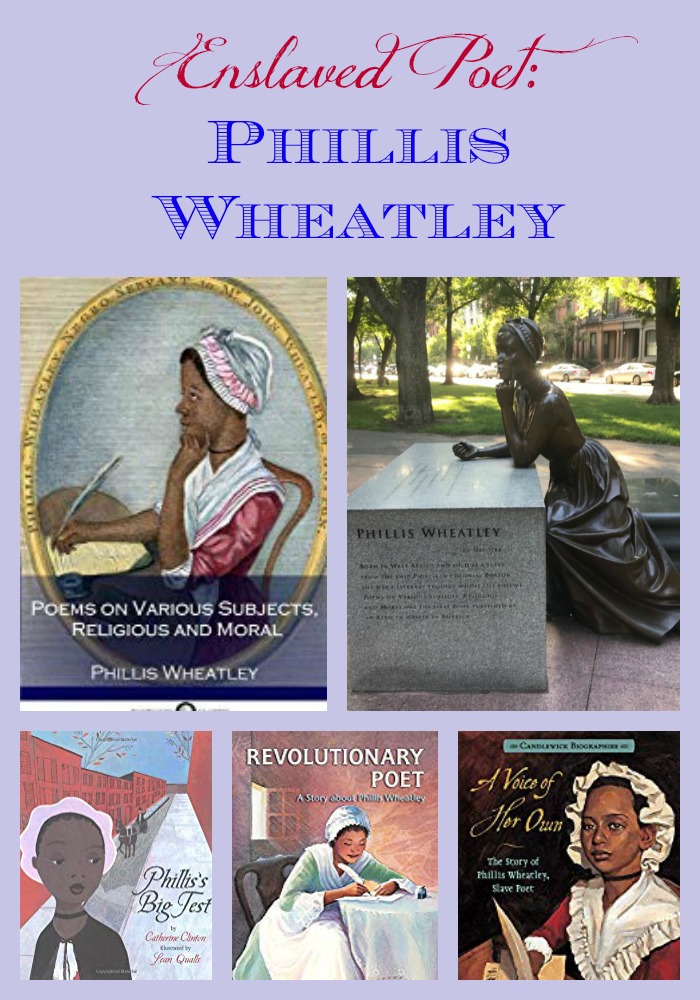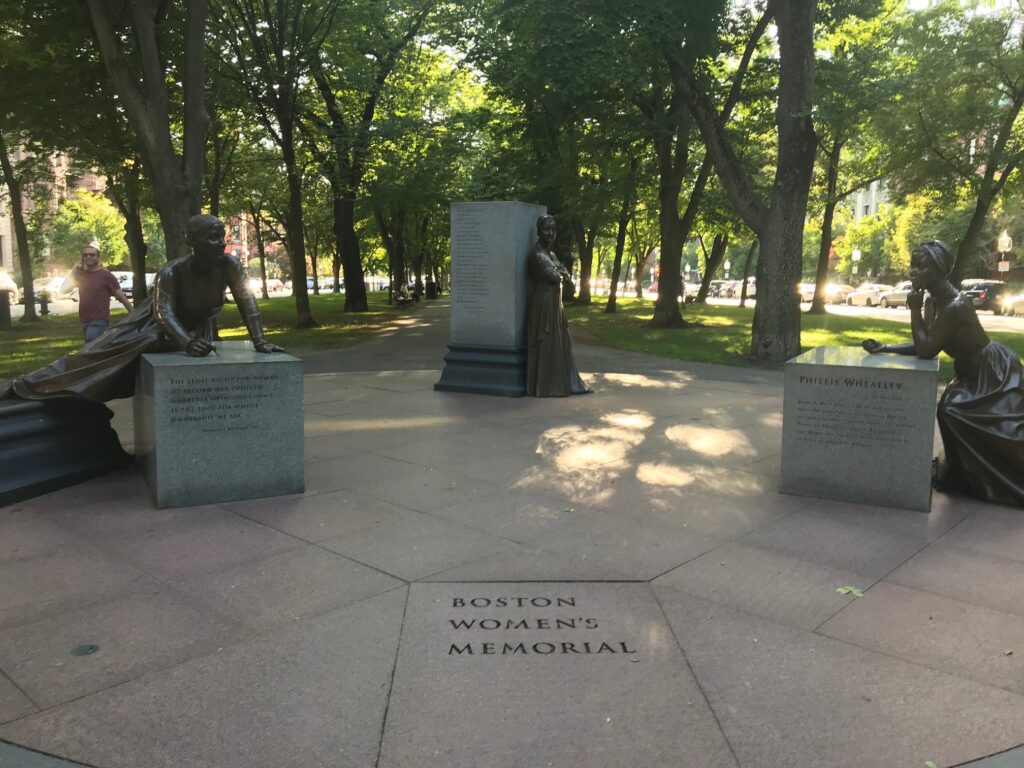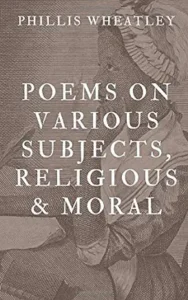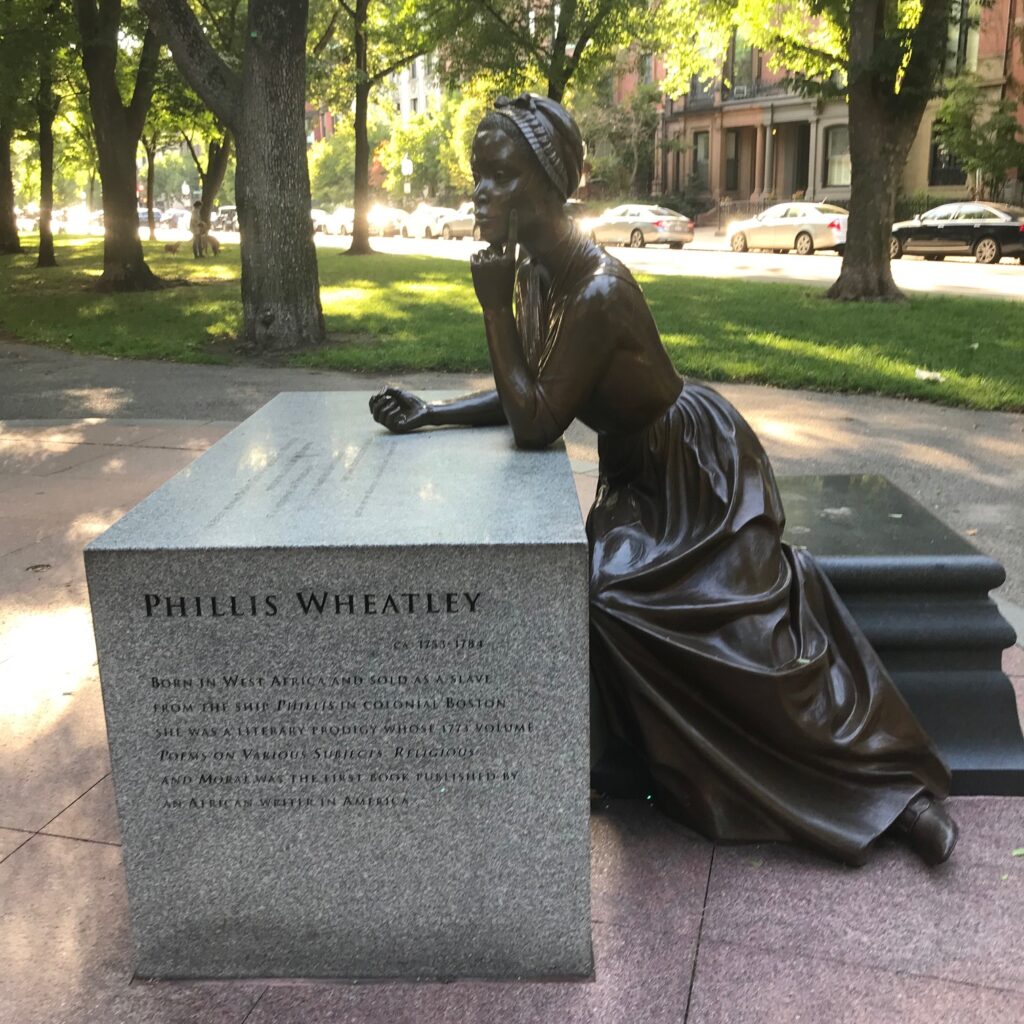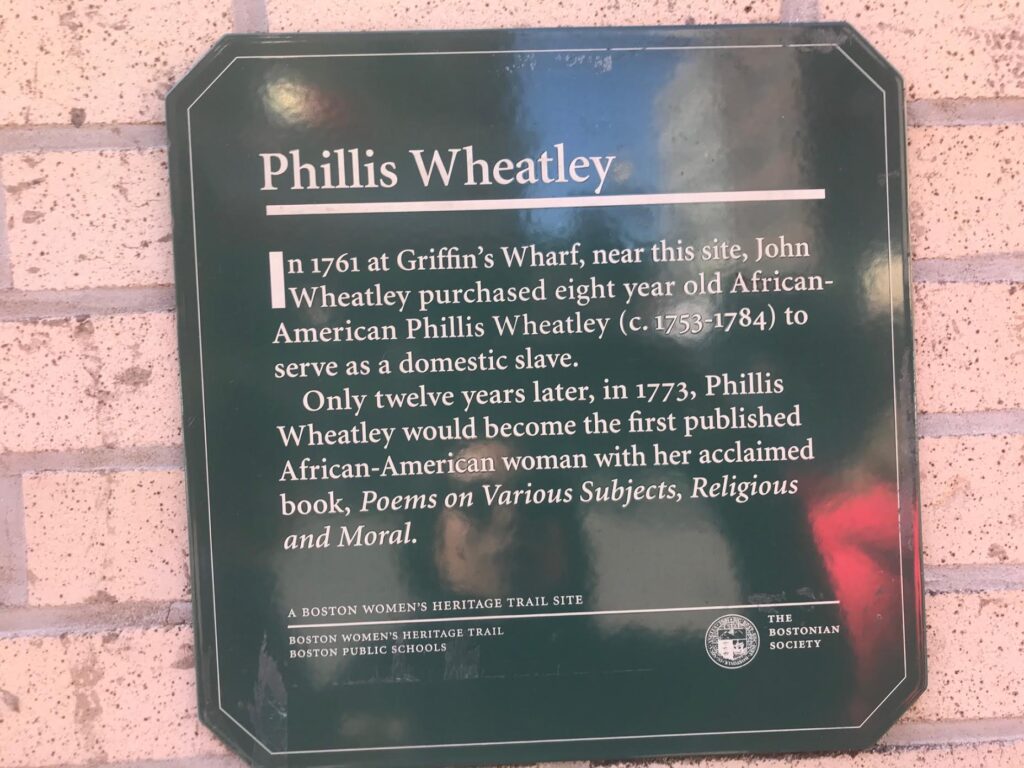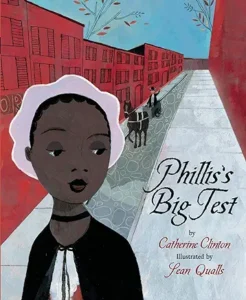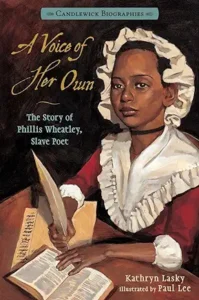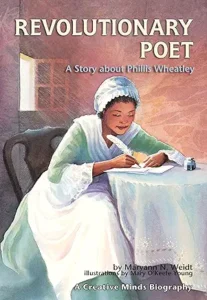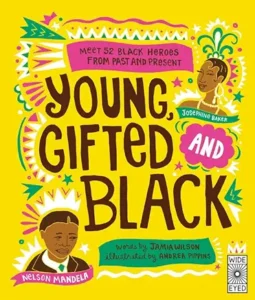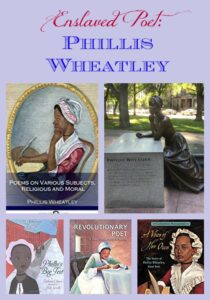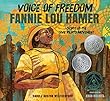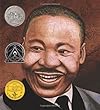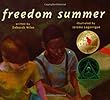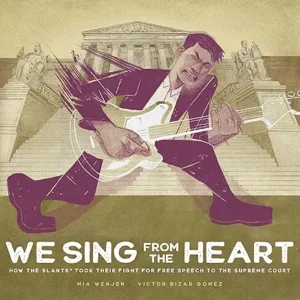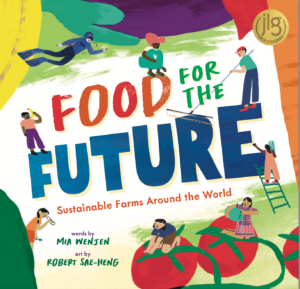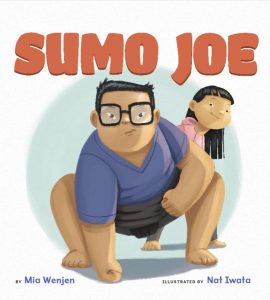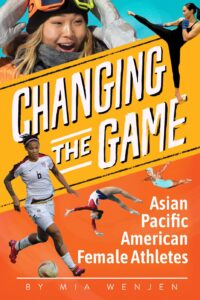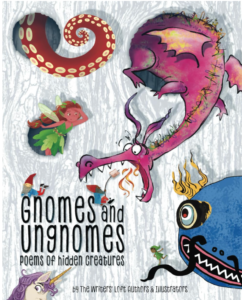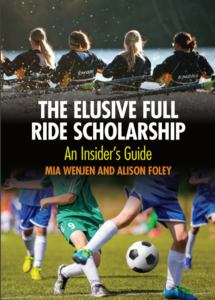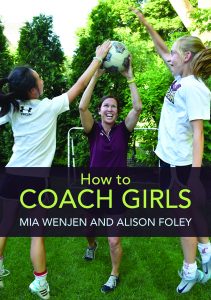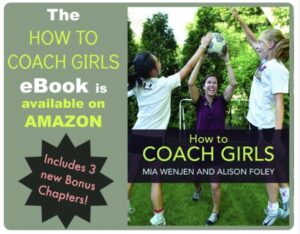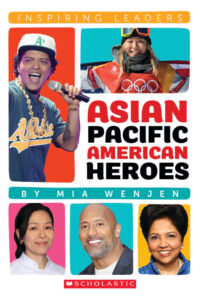The three women of the Boston Women’s Memorial are Abigail Adams, Phillis Wheatley, and Lucy Stone. I posted on Lucy Stone here. Today I wanted to learn more about Phillis Wheatley.
Phillis Wheatley was the first African-American woman to publish a book of poetry. Educated by the people who enslaved her, Phillis mastered Greek and Latin. She became well-known for her poetry and became the poster child for the early abolitionist movement. Her collection, Poems on Various Subjects, Religious and Moral, was published on September 1, 1773, with the help of the Countess of Huntingdon in England.
She was granted her freedom when she returned and married John Peters in 1778, also a free African American. They lived in Boston and had three children, all of whom died in infancy. No one would publish her second book of poetry and they struggled with poverty. Ultimately, Phillis was forced to work as a maid in a boarding house, living in squalid conditions. She died in Boston on December 5, 1784, at thirty-one years old. The poems for her second book of poetry have never been recovered.
An original copy of her book is on display at Old South Meeting Church in Boston. It’s a reminder to me that Boston is full of living history.
Phillis Wheatley (1753–1784)
Wheatley was the abolitionists’ illustrative testimony that blacks could be both artistic and intellectual.
“Wheatley was seized from Senegal/Gambia, West Africa when she was about seven years old. She was transported to the Boston docks with a shipment of “refugee” slaves, who because of age or physical frailty were unsuited for rigorous labor in the West Indian and Southern colonies, the first ports of call after the Atlantic crossing. In the month of August 1761, “in want of a domestic,” Susanna Wheatley, wife of prominent Boston tailor John Wheatley, purchased “a slender, frail female child … for a trifle” because the captain of the slave ship believed that the waif was terminally ill, and he wanted to gain at least a small profit before she died.
After discovering the girl’s precociousness, the Wheatleys, including their son Nathaniel and their daughter Mary, did not entirely excuse Wheatley from her domestic duties but taught her to read and write. Soon she was immersed in the Bible, astronomy, geography, history, British literature and the Greek and Latin classics of Virgil, Ovid, Terence, and Homer.” from Poetry Foundation
On Being Brought from Africa to America
PHILLIS WHEATLEY
‘Twas mercy brought me from my Pagan land,
Taught my benighted soul to understand
That there’s a God, that there’s a Saviour too:
Once I redemption neither sought nor knew.
Some view our sable race with scornful eye,
“Their colour is a diabolic die.”
Remember, Christians, Negros, black as Cain,
May be refin’d, and join th’ angelic train.
She [Phillis Wheatley] often spoke in explicit biblical language designed to move church members to decisive action. For instance, these bold lines in her poetic eulogy to General David Wooster castigate patriots who confess Christianity yet oppress her people
But how presumptuous shall we hope to find
Divine acceptance with the Almighty mind
While yet o deed ungenerous they disgrace
And hold in bondage Afric: blameless race
Let virtue reign and then accord our prayers
Be victory ours and generous freedom theirs.”
from Poetry Foundation
Walking around Chinatown, I discovered this plaque on Tyler Street near Beach Street. This spot marks a slave-trading auction site.
Griffin’s Wharf is also where the Boston Tea Party took place:
The Beaver, Dartmouth, and Eleanor were moored at Griffin’s Wharf in Boston. It is at this location where the December 16, 1773 destruction of the tea occurred. The original location of the Boston Tea Party no longer exists because of extensive landfills that destroyed the location. This was caused by the city of Boston’s rapid expansion in the 19th century. In 18th century Boston, Griffin’s Wharf was a bustling center for maritime commerce and shipping. The exact location of the original Griffin’s Wharf is open to debate, but the Boston Tea Party Ships & Museum, located on the Congress Street Bridge, is located near the approximate area where the Boston Tea Party took place. A historical marker commemorating the Boston Tea Party stands on the corner of Congress and Purchase streets. Boston Tea Party Ship
Children’s Books About Phillis Wheatley
Phillis’s Big Test by Catherine Clinton, illustrated by Sean Qualls
In 1772, printers in colonial Boston did not believe that a teenage African American enslaved girl could write poetry, let alone exceptional poetry. Brought before eighteen learned men, Phillis had to prove that she wrote the poems that she hoped to publish.
This picture book ends with an Epilogue that Phillis passed with flying colors but it omits that she was never able to find a publisher in the United States. They wrote that they believed the poems were written by “Phillis, a young Negro girl, who was but a few years since, brought an uncultivated Barbarian from Africa … and now is … a slave.”
Her first book of poems was published in England and her second book of poetry was never published and those poems have disappeared. [picture book, ages 4 and up]
A Voice of Her Own: The Story of Phillis Wheatly, Slave Poet by Kathryn Lasky, illustrated by Paul Lee
In the North, it was not against the law to teach a black person to read or write, but it was never done. Susannah Wheatley, Phillis’ mistress, encouraged her education. Phillis mastered Greek and Latin, mathematics, and geography, as well as served her mistress. But poetry was her love. This book parallels the colonists’ struggle for freedom from English rule with Phillis’s life as an enslaved poet. [advanced picture book, ages 8 and up]
Revolutionary Poet: A Story about Phillis Wheatley by Maryann N. Weidt, illustrated by Mary O’Keefe Young
Caught between two worlds as an educated African American slave, Phillis Wheatley supported the colonists’ fight for freedom against the King of England with her writing talents. Her mistress, Susannah Wheatley, was the driver behind Phillis’s published works, but while Phillis received benefits as a famous author, she was still enslaved. Upon her return from England where Phillis was sent to get her book published, her master, John Wheatley, granted her freedom though she continued to live at the Wheatley home and care for her ailing mistress. [middle grade biography, ages 9 and up]
For more Black heroes, try this great anthology:
Young, Gifted, and Black: Meet 52 Black Heroes from Past and Present by Jamia Wilson, illustrated by Andrea Pippins
Phillis Wheatley didn’t make this list because there are a lot of luminaries that fit these criteria, and Jamia Wilson pulls from around the world. Other writers include Chimamanda Ngozi Adichie, Malorie Blackman, Alexandre Dumas, Maya Angelou, and Zodie Smith. And that’s just the writers! Meet athletes, activists, musicians, chess masters, scientists, and more in this inspiring nonfiction book. [nonfiction anthology, ages 7 and up]
To examine any book more closely at Amazon, please click on image of book.
As an Amazon Associate, I earn from qualifying purchases.
African American Book Lists for Kids
Black History Month with Carole Boston Weatherford
Five African American Who Excelled in the Arts
African American Pioneering Female Musicians
HARLEM: Found Ways art exhibit and Children’s Books Reflecting Harlem
Civil Rights Movement Books for 4th Grade
Top 10: Best Children’s Books On Civil Rights Movement
This list covers picture books, chapter books, and young adult.
Top 10: Best African-American Picture Books (ages 4-12)
If you read these picture books in order, it gives an overview of the African-American experience historically starting from slavery to the present day.
Ruby Bridges and Picture Book As Fast as Words Could Fly
Meeting Ruby Bridges was a thrill for me and further reinforced how important it is for kids to learn about the Civil Rights Movement.
Young Booker T. Washington: Fifty Cents and a Dream.
An advanced picture book that paints a portrait of Booker T. Washington as a determined young boy.
Celebrating Martin Luther King, Jr with Three Books
If you just want a snapshot of the Civil Rights Movement for young children, try these three books: two picture books and a chapter book.
5 Feel-Good Picture Books About Africa
These five books show different perspectives from the story of a young Masai girl who wants to touch the moon to visiting family in Tanzania and The Gambia.
Children’s Africana Book Award
Africa Access was founded in 1989 to help schools, public libraries, and parents improve the quality of their K-12 collections on Africa.
2010 Africana Awards for Best Children’s Literature
5th Grade Social Studies And How to Make It Interesting
I have a section in this post about the Civil Rights Movement.
Black History Month Books for Kids and Teens
Gordon Parks: Black History Month
Follow PragmaticMom’s board Multicultural Books for Kids on Pinterest.
Follow PragmaticMom’s board Children’s Book Activities on Pinterest.
My books:
Amazon / Signed or Inscribed by Me
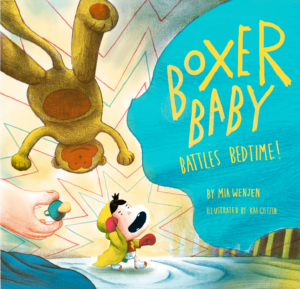 Amazon / Signed or Inscribed by Me
Amazon / Signed or Inscribed by Me
Food for the Future: Sustainable Farms Around the World
- Junior Library Guild Gold selection
- Selected as one of 100 Outstanding Picture Books of 2023 by dPICTUS and featured at the Bologna Children’s Book Fair
- Starred review from School Library Journal
- Chicago Library’s Best of the Best
- 2023 INDIES Book of the Year Awards Finalist
- Green Earth Book Award longlist
- Imagination Soup’s 35 Best Nonfiction Books of 2023 for Kids
Amazon / Barefoot Books / Signed or Inscribed by Me

